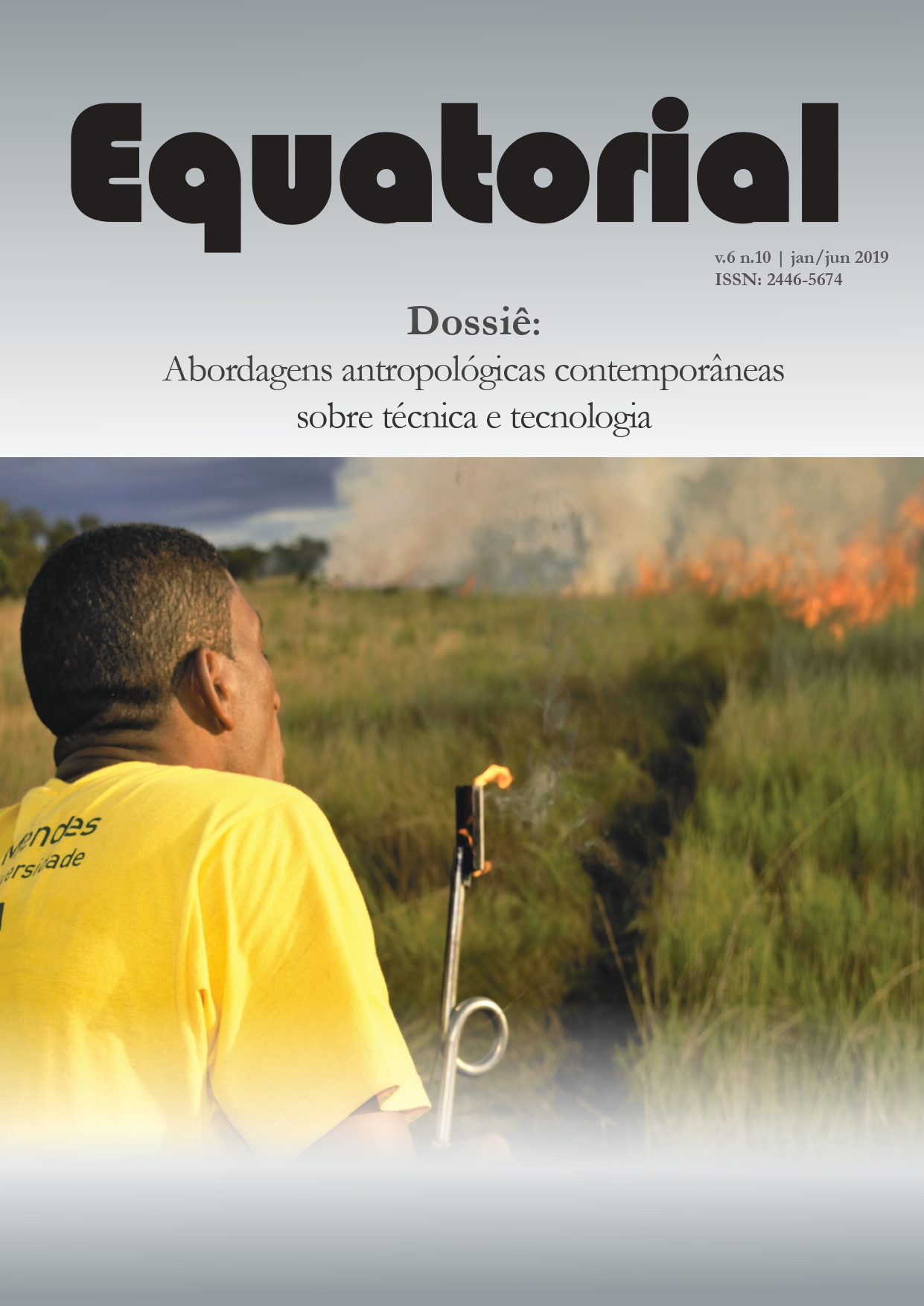Fazendo renda em casa e ‘no curso’:
aprendizagem na prática
DOI:
https://doi.org/10.21680/2446-5674.2019v6n10ID15334Keywords:
Antropologia da aprendizagem; técnica; renda de bilros; engajamento; práticaAbstract
The article seeks to present the process of apprenticeship of the bobbin lace, based on observations from the domestic environment and the lace classes. The objective is to highlight that the main elements of these process are the same. Independent of the context the apprenticeship takes place in practice and what matters are aspects such as the active engagement of the apprentice, his will and effort, beyond the repetitions and the attentive observation.
Downloads
References
BENJAMIN, Walter. Brinquedo e brincadeira: observações sobre uma obra monumental. In: Magia e técnica, arte e política: ensaios sobre literatura e história da cultura. 6ª edição. São Paulo: Brasiliense, 1994, (Obras Escolhidas, 1). Pp. 267-271.
BRIL, Blandine. L’apprentissage de gestes techniques: ordre de contraintes et variations culturelles. In: ROUX, Valentine; BRIL, Blandine (Ed.). Le geste technique: réflexions méthodologiques et anthropologiques. Ramonville Saint-Agne: Editions Erès, 2002. p. 113–150.
BRUSSI, Júlia Dias Escobar. Da "renda roubada" à renda exportada: a produção e a comercilização da renda de bilros em dois contextos cearenses. 2009. 145f. Dissertação (Mestrado) - Programa de Pós-Graduação em Antropologia Social, Departamento de Antropologia, Universidade de Brasília, Brasília – DF, 2009.
BRUSSI, Júlia Dias Escobar. Batendo bilros: rendeiras e rendas em Canaan (Trairi - CE). 2015. 223f. Tese (Doutorado) — Programa de Pós-Graduação em Antropologia Social, Departamento de Antropologia, Universidade de Brasília, Brasília – DF, 2015.
CHAMOUX, Marie-Noëlle. Les Savoir-faire techniques et leur appropriation : le cas des Nahuas du Mexique. L’Homme, Paris, v. 21, n. 3, p. 71–94, 1981. ISSN 0439-4216. Disponível em: https://www.persee.fr/doc/hom_0439-4216_1981_num_21_3_368206 . Acesso em: 10 set 2015.
____________. La transmission des savoir-faire: un objet pour l’ethnologie des techniques? Techniques & Culture, Paris ,v. 1, n. 54-55, p. 139–161, 2010.
DANTAS, Beatriz Góis. “Tu me ensina a fazer renda": gerações e processos de aprendizagem de ofícios tradicionais. Revista do Patrimônio Histórico e Artistico Nacional, Brasília, vol. 32, p. 225–243, 2005.
DELBOS, Geneviève; JORION, Paul. La transmission des savoirs. Paris: Maison des Sciences de l’Homme, 1984.
GIBSON, James. The ecological approach to visual perception. Hillsdale: Lawrence Erlbaum Associates, 1986.
HANKS, William F. Foreword. In: LAVE, Jean; WENGER, Etienne. Situated learning: legitimate peripheral participation. Cambridge: Cambridge University Press, 1999, (Learning in doing). p. 13–24.
HERZFELD, Michael. The body impolitic: artisans and artifice in the global hierarchy of value. Chicago: University of Chicago Press, 2004.
INGOLD, Tim. The optimal forager and economic man. In: The perception of the environment: essays on livelihood, dwelling & skill. London: Routledge, 2002a. p. 27–39.
____________. Of string bags and birds’ nests: skill and the construction of artefacts. In: The perception of the environment: essays on livelihood, dwelling & skill. London: Routledge, 2002b. p. 349–361.
____________. Da transmissão de representações à educação da atenção. Educação, v. 33, n. 1, p. 6–25, mar. 2010. Disponível em: http://revistaseletronicas.pucrs.br/ojs/index.php/faced/article/view/6777. Acessado em: 18 jun 2018.
LAVE, Jean. Situated learning in communities of practice. In: RESNICK, Lauren B.; LEVINE, John M.; TEASLEY, Stephanie D. (Ed.). Perspectives on socially shared cognition. Washington, DC: American Psychological Association, 1991. p. 63–82.
____________. The practice of learning. In: CHAIKLIN, Seth; LAVE, Jean (Ed.). Understanding practice: perspectives on activity and context. Cambridge: Cambridge University Press, 1996.
____________. Apprenticeship in critical ethnographic practice. Chicago: University of Chicago Press, 2011. (The Lewis Henry Morgan lectures).
LAVE, Jean; WENGER, Etienne. Situated learning: legitimate peripheral participation. Cambridge: Cambridge University Press, 1999. (Learning in doing).
MARCHAND, Trevor H. J. Introduction: Making knowledge: explorations of the indissoluble relation between mind, body, and environment. In: MARCHAND, Trevor H. J. (Ed.). Making knowledge: explorations of the indissoluble relation between mind, body and environment. Malden, MA: Wiley-Blackwell, 2010. p. 01–20.
MATOS, Sônia Missagia. Artefatos de gênero na arte do barro. Vitória: EDUFES, 2001.
MAUSS, Marcel. As técnicas do corpo. In: Sociologia e antropologia. São Paulo: Cosac Naify, 2003. p. 399–422.
MENDONÇA, Maria L. P. de. Algumas considerações sobre rendas e rendeiras do Nordeste. Boletim de Antropologia, v. 3, n. 1, p. 39–76, 1959.
PARADISE, Ruth; ROGOFF, Barbara. Side by Side: Learning by Observing and Pitching In. Ethos, v. 37, n. 1, p. 102–138, mar. 2009.
PORTISCH, Anna Odland. The craft of skilful learning: Kazakh women’s everyday craft practices in western Mongolia. In: MARCHAND, Trevor H. J. (Ed.). Making knowledge: explorations of the indissoluble relation between mind, body and environment. Malden, MA: Wiley-Blackwell, 2010. p. 59–75.
ROUX, Valentine; BRIL, Blandine. Observation et expérimentation de terrain : des collaborations fructueuses pour l’analyse de l’expertise technique. Le cas de la taille de pierre en Inde. In: ROUX, Valentine; BRIL, Blandine (Ed.). Le geste technique: réflexions méthodologiques et anthropologiques. Ramonville Saint-Agne: Editions Erès, 2002. p. 29–48.
SAUTCHUK, Carlos Emanuel. O arpão e o anzol: técnica e pessoa no estuário do Amazonas (Vila Sucuriju, Amapá). 2007, 402f. Tese (Doutorado) — Programa de Pós-Graduação em Antropologia Social, Departamento de Antropologia, Universidade de Brasília, Brasília – DF, 2007.
_____________. Aprendizagem como gênese: prática, skill e individuação. Horizontes Antropológicos, v. 21, n. 44, p. 109–139, dez. 2015.
STRAUSS, Claudia. Beyond “Formal” versus “Informal” Education: Uses of Psychological Theory in Anthropological Research. Ethos, v. 12, n. 3, p. 195–222, out. 1984.
Downloads
Published
How to Cite
Issue
Section
License
Autores mantém os direitos autorais e concedem à revista o direito de primeira publicação, com o trabalho simultaneamente licenciado sob a Licença Creative Commons Attribution que permite o compartilhamento do trabalho com reconhecimento da autoria e publicação inicial nesta revista.

 Português (Brasil)
Português (Brasil) English
English Español (España)
Español (España)


